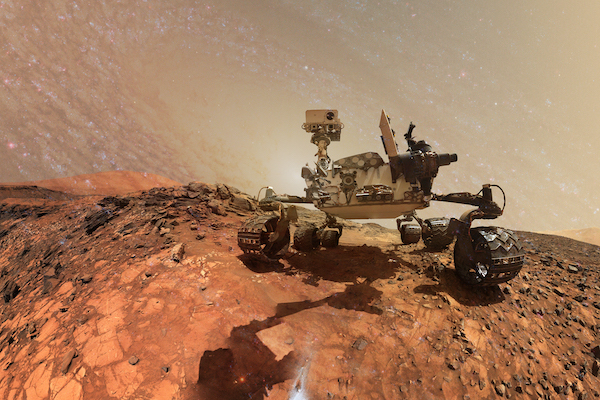The state-of-the-art Mars Rover has 17 cameras surrounding the state-of-the-art machine functions, such as navigational, descent imaging, and other scientific investigation.
Below are some cameras that surround the durable Rover, allowing NASA to study the terrain, rocks, soil, and chemical elements under the surface.
Hazard Cameras
The engineering cameras serve as hazard lenses linked to the AI software, allowing the Rover to anticipate obstacles independently. Although the cameras are black and white, they utilize available light to capture 3D images.
These “eyes” also have a wide-angle field of view (up to 120 degrees) and can map out the terrain at a distance of ten feet in front of the Rover. However, these hazard cameras cannot rotate independently, so they must be mounted strategically to cover as much area as possible.
Descent Imager
The MARDI or Mars Descent Imager can record videos up to four frames per second at high definition. In addition, the images the cameras send are put in a category as “true color,” which means that the tint is similar to what an average human eye perceives.
The MARDI also collects data to check the wind profile or map out the landing site, particularly the geomorphic and geologic characteristics of the surface as the Rover approaches the landing site.
Navigational Cameras
The NavCams are mounted on the Rover’s head and neck. The twin cameras sit about 16.2 inches apart, and their primary function is autonomous exploration. These black-and-white lenses utilize visible light to capture 3D images. Each lens has a FOV of 45 degrees, working hand-in-hand with the hazard cameras to cover a wider area.
Science Cameras
The Mars Rover also utilizes four cameras dedicated to scientific investigation. These are Chemistry and Camera (ChemCam), Mast Camera (MastCam), and the Mars Hand Lens Imager (MAHLI).
ChemCam
Emits laser and studies the vaporized Martian soils and rocks on areas smaller than one millimeter. A remote micro-imager also allows the ChemCam to capture grayscale images.
MastCam
The system consists of twin cameras with a powerful zoom lens attached to a mast, hence the name. Their primary function is to record colored video footage, photographs, and 3D stereo images by merging similar pictures taken at different angles.
MAHLI
The camera captures extreme close-up angles of structures, textures, and minerals on the surface, including dust and debris. The MAHLI can capture and send images smaller than a single strand of human hair.
PIXL
The name stands for Planetary Instrument for X-ray Lithochemistry, which identifies elements at a microscopic scale. For example, the design of the lens is for allowing it to send high images the size of a single grain of table salt. It can send data back to NASA by as much as two megabytes daily.
Previous iterations of the Rover do not have telephoto lenses. But Curiosity’s MastCam features a 100-mm lens (focal length) that can capture thrice the resolution of the images that Spirit and Opportunity sent. So, for instance, it can identify an object from 700 yards away.
All these high-tech cameras work in conjunction to capture and send detailed images and videos never seen before of the Red Planet.
